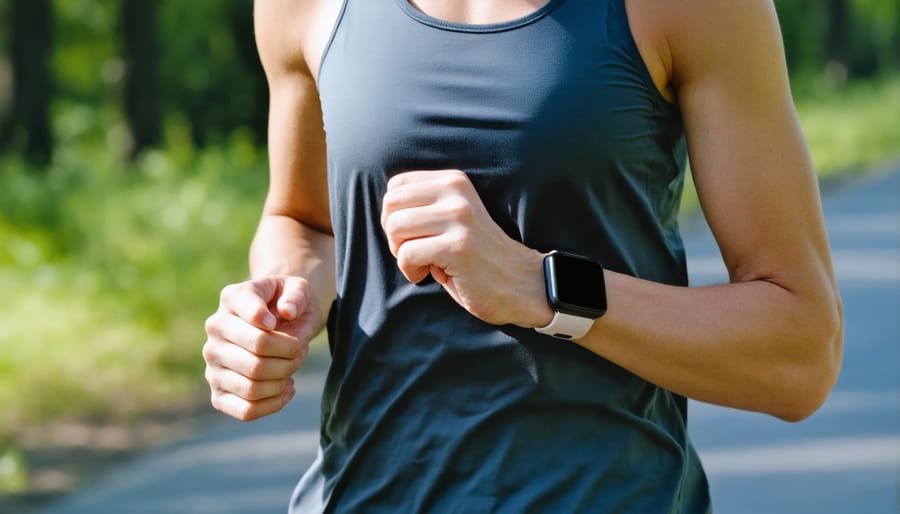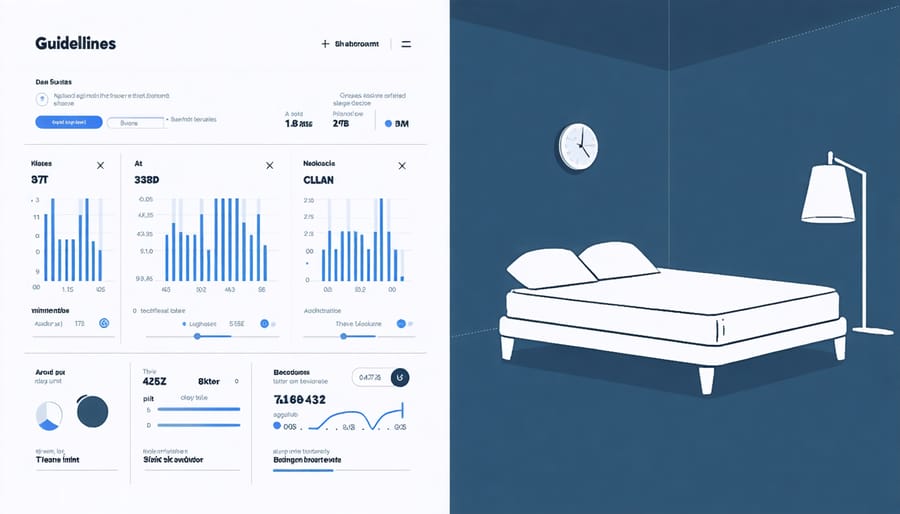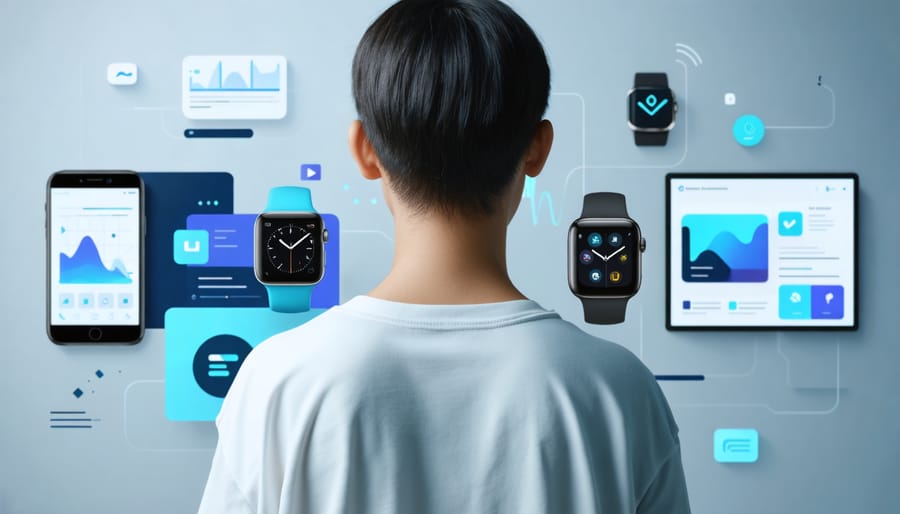Digital health tools have revolutionized how we manage our physical and mental well-being, offering powerful ways to transform your health journey. From smart watches tracking sleep patterns to meditation apps guiding mindfulness practices, technology now serves as a personal health companion for millions of Canadians. These digital solutions provide real-time feedback, personalized recommendations, and evidence-based strategies to improve overall wellness.
The integration of health apps, wearable devices, and virtual care platforms has created unprecedented opportunities for individuals to take control of their health journey. Whether monitoring daily step counts, accessing virtual therapy sessions, or following guided workout routines, digital wellness tools make health management more accessible, measurable, and sustainable than ever before.
This practical guide explores proven digital health examples that enhance physical activity, mental wellness, nutrition tracking, and sleep quality, helping you build a comprehensive approach to modern health management. By understanding and implementing these digital solutions effectively, you can create a balanced, technology-supported wellness routine that aligns with your personal health goals.
Smart Health Tracking for Better Physical Wellness
Wearable Fitness Technology
Wearable fitness technology has revolutionized how Canadians track and improve their health. Smart devices like the Apple Watch, Fitbit, and Garmin watches offer comprehensive health monitoring features that go far beyond simple step counting. These devices can track heart rate, sleep patterns, stress levels, and even blood oxygen levels, providing valuable insights into your overall well-being.
Modern fitness trackers use advanced sensors to monitor physical activity throughout the day, helping users stay accountable to their fitness goals. Many devices now include features like workout guidance, automated activity recognition, and personalized coaching suggestions based on your activity patterns and health metrics.
The sleep tracking capabilities of these devices are particularly valuable, offering detailed analysis of sleep stages, duration, and quality. This information helps users understand their rest patterns and make adjustments for better sleep hygiene. Additionally, many wearables now include stress monitoring features that measure heart rate variability and suggest breathing exercises when stress levels are elevated.
Most wearables sync with smartphone apps that provide comprehensive health dashboards, making it easy to track progress over time. These apps often integrate with other health platforms and can share data with healthcare providers, contributing to more informed health discussions and personalized care plans.

Digital Nutrition and Meal Planning Apps
Digital nutrition and meal planning apps have revolutionized how Canadians approach healthy eating and dietary management. Popular apps like MyFitnessPal and LoseIt offer comprehensive food tracking features, allowing users to log meals, monitor caloric intake, and track essential nutrients. These apps often include extensive Canadian food databases, making it easier to track locally available products and restaurant meals.
Smart meal planning apps such as Mealime and Cookspiration help users create balanced weekly meal plans, generate shopping lists, and discover healthy recipes that align with their dietary preferences and restrictions. Many of these apps can accommodate specific dietary needs, including vegetarian, vegan, gluten-free, and diabetes-friendly options.
Some advanced nutrition apps now incorporate artificial intelligence to provide personalized recommendations based on your eating patterns, health goals, and lifestyle factors. Features like barcode scanning, portion size visualization tools, and integration with smart kitchen scales make tracking more accurate and convenient.
For those managing specific health conditions, apps like Fooducate help decode nutrition labels and provide detailed information about food additives and ingredients. Many of these apps also offer community features where users can share recipes, tips, and success stories, creating supportive environments for sustainable dietary changes.
Remember to choose apps that are evidence-based and, when possible, endorsed by registered dietitians or reputable health organizations.
Mental Health in the Digital Age
Meditation and Mindfulness Apps
In today’s fast-paced world, digital meditation and mindfulness apps have become valuable tools for Canadians seeking to incorporate mind-body therapies into their daily routines. These apps offer guided meditation sessions, breathing exercises, and mindfulness practices that can help reduce stress, improve focus, and enhance overall mental well-being.
Popular apps like Calm and Headspace provide structured programs suitable for both beginners and experienced practitioners. They offer features such as sleep stories, anxiety-reducing meditations, and mindful movement exercises. The Insight Timer app stands out with its extensive library of free content, including thousands of guided meditations led by qualified instructors from various traditions.
Canadian-made apps like Petit BamBou and Mind Shift offer content specifically tailored to Canadian users, with options in both English and French. These apps often include mood tracking features, progress monitoring, and customizable meditation timers to help users maintain consistent practice.
For those new to meditation, apps like Ten Percent Happier and Simple Habit offer bite-sized sessions perfect for busy schedules. They provide clear instructions and practical techniques that can be applied throughout the day, from morning commutes to lunch breaks.
Many of these apps integrate with health tracking devices and smartphones to monitor stress levels and sleep quality, providing users with valuable insights into their mental health patterns. Some apps also offer community features, allowing users to connect with others on similar wellness journeys, share experiences, and maintain motivation through group challenges and meditation statistics.

Virtual Therapy and Support Platforms
Virtual therapy and mental health support platforms have revolutionized access to mental healthcare, making it more convenient and accessible for Canadians. These digital solutions offer secure video sessions, messaging, and support groups from the comfort of your home.
Popular platforms like BetterHelp and Talkspace connect users with licensed therapists who specialize in various areas, including anxiety, depression, relationships, and stress management. Many Canadian healthcare providers now offer their own telehealth mental health services through secure platforms, ensuring compliance with provincial healthcare regulations.
These digital solutions typically offer flexible scheduling options, with some providing 24/7 access to support through text messaging. Users can choose between video calls, phone sessions, or text-based therapy, allowing them to engage in ways that feel most comfortable for them.
Beyond one-on-one therapy, many platforms offer guided meditation sessions, mood tracking tools, and interactive mental health exercises. Some apps include community features where users can join support groups and connect with others facing similar challenges, creating a sense of belonging and shared experience.
For those with employee benefits, many workplace insurance plans now cover virtual therapy sessions, making mental health support more financially accessible. Some platforms also offer sliding scale fees based on income levels.
The effectiveness of virtual therapy has been well-documented, with studies showing comparable results to in-person sessions for many mental health concerns. While virtual platforms may not suit everyone’s needs, they represent a valuable option for those seeking mental health support, especially in remote areas or during times when in-person visits aren’t practical.
Sleep and Recovery Technology
Sleep Tracking Apps and Devices
In today’s digital age, sleep tracking apps and devices have become valuable tools to help Canadians improve sleep quality and understand their rest patterns better. Popular options include wearable devices like Fitbit and Apple Watch, which monitor sleep stages, heart rate, and movement throughout the night. These devices provide detailed insights into sleep duration, cycles, and potential disruptions.
Smartphone apps like Sleep Cycle and SleepScore offer a more accessible entry point, using your phone’s sensors to track sleep patterns and wake you during your lightest sleep phase. Many of these apps also include features like white noise, guided meditation, and smart alarms to help establish better sleep routines.
For those seeking comprehensive sleep analysis, smart mattress pads and bedside devices can monitor breathing patterns, room temperature, and environmental factors that might affect sleep quality. These tools typically generate weekly or monthly reports, helping users identify trends and make informed adjustments to their sleep habits.
When choosing a sleep tracking solution, consider factors like ease of use, accuracy, and the type of data you want to monitor. Remember that while these tools can provide valuable insights, they should complement, not replace, basic sleep hygiene practices such as maintaining consistent sleep schedules and creating a relaxing bedtime routine.

Digital Recovery Assistants
In today’s digital age, recovery and stress management have become more accessible through innovative apps and devices. Popular recovery apps like Calm and Headspace offer guided meditation sessions and breathing exercises, helping Canadians unwind after intense workouts or stressful days. These digital assistants use evidence-based techniques to promote better sleep, reduce muscle tension, and enhance overall well-being.
Smart wearables now include recovery-tracking features that monitor heart rate variability, sleep quality, and stress levels. These metrics help users understand when they need to prioritize rest and recovery. Many devices offer personalized recommendations based on activity levels and recovery status, ensuring a balanced approach to fitness and health.
Recovery-focused apps like Noom and MyFitnessPal include features for tracking nutrition and hydration, essential components of post-workout recovery. They provide customized meal suggestions and remind users to stay hydrated throughout the day.
For stress management, apps like Insight Timer and Breathe offer quick, practical exercises that can be done anywhere. These tools incorporate proven relaxation techniques, including progressive muscle relaxation, guided imagery, and mindfulness practices.
Some devices also integrate with smart home systems, automatically adjusting lighting and temperature for optimal recovery conditions. These environmental controls, combined with gentle reminder notifications, help create a more conducive environment for rest and recuperation.
Integrating Digital Health Tools Safely
While digital health tools offer tremendous benefits for monitoring and improving our well-being, it’s essential to adopt a balanced approach to wellness when incorporating these technologies into our daily lives. Here are key strategies for safe and mindful integration:
Set boundaries for app usage by designating specific times for health tracking and monitoring. This helps prevent the tools from becoming sources of stress or obsession. Consider using built-in screen time limiters or app timers to maintain healthy digital boundaries.
Protect your personal health information by:
– Using strong, unique passwords for all health apps
– Enabling two-factor authentication when available
– Reading privacy policies carefully before sharing data
– Only downloading apps from official sources
– Regularly reviewing app permissions and data sharing settings
Create a sustainable routine by starting with one or two apps that align with your primary health goals. This prevents overwhelming yourself with too many tracking tools and helps build lasting habits. Choose apps that integrate well with each other to streamline your health monitoring experience.
To avoid technology addiction:
– Turn off non-essential notifications
– Schedule regular digital detox periods
– Use offline tracking methods occasionally
– Focus on qualitative well-being indicators, not just numbers
– Listen to your body’s signals rather than relying solely on digital feedback
Remember that digital health tools should enhance, not replace, traditional healthcare practices. Always consult healthcare professionals for medical advice and use these tools as supplementary resources for your overall health journey.
When sharing health data with healthcare providers, use secure platforms and verified channels. Many Canadian healthcare institutions now offer patient portals and approved apps for safe information exchange.
Digital health tools have revolutionized how we approach personal wellness, offering convenient and effective ways to monitor, maintain, and improve our health. From fitness trackers that keep us moving to meditation apps that support our mental well-being, these technologies have become valuable allies in our health journey.
The benefits of digital health solutions are clear: they provide real-time health data, personalized recommendations, and convenient access to health resources. They help us stay accountable, track our progress, and make informed decisions about our well-being. For many Canadians, these tools have become essential components of their daily health routines.
However, it’s important to remember that technology should enhance, not replace, traditional health practices. The key to success lies in finding the right balance. Start by identifying your health priorities and selecting tools that align with your goals. Begin with one or two applications that feel most relevant to your needs, and gradually incorporate others as you become comfortable.
Remember to practice mindful technology use and take regular digital breaks. The goal is to use these tools to create sustainable, healthy habits while maintaining a balanced relationship with technology. By thoughtfully incorporating digital health solutions into your wellness routine, you can harness their benefits while preserving the essential human elements of health and well-being.
Consider consulting with healthcare providers about which digital tools might best support your health journey. With the right approach, digital health technologies can be powerful allies in achieving and maintaining optimal health.

